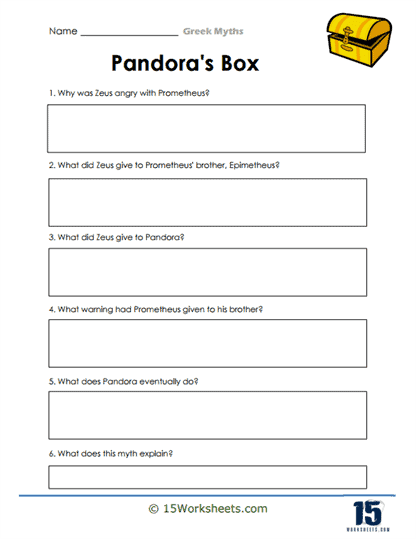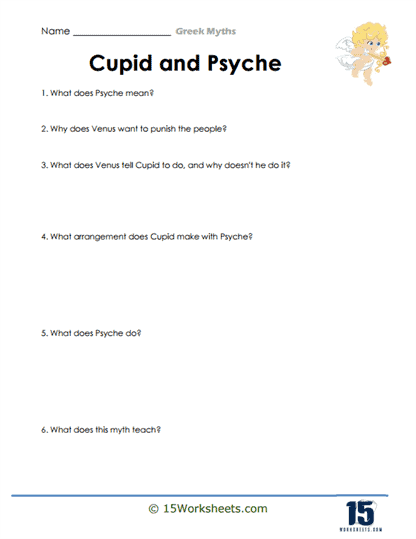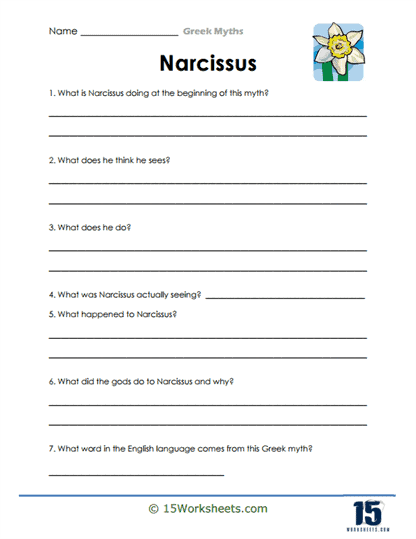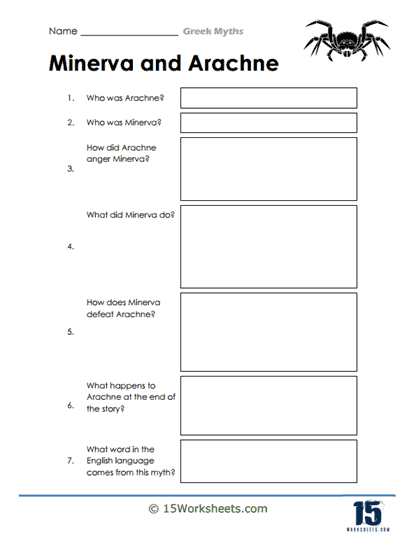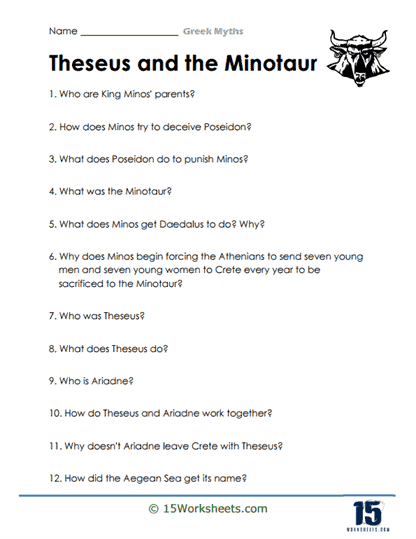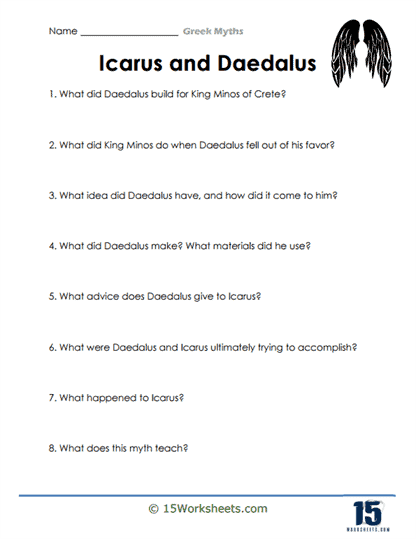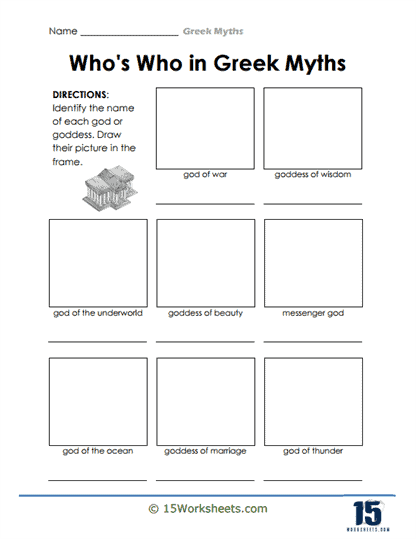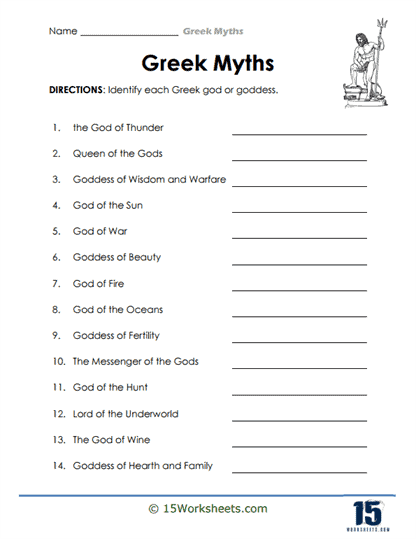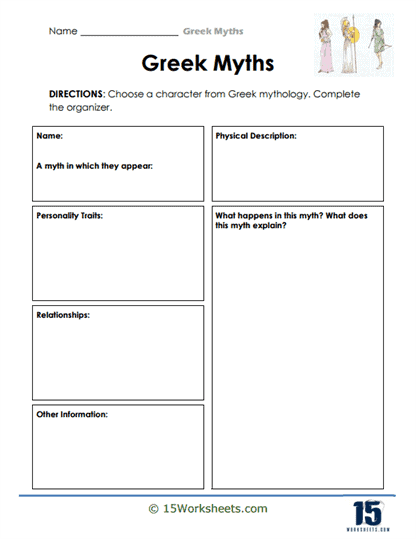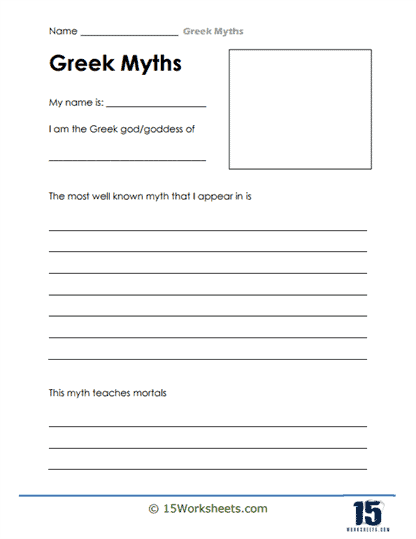Greek Myths Worksheets
All About These Worksheets
These worksheets can enhance student understanding and appreciation of Greek mythology, a body of myths and legends from Ancient Greece. These stories, involving gods, heroes, and creatures, have had an enduring influence on Western culture, shaping our literature, art, philosophy, and even our understanding of the human condition.
Our Greek Myth worksheets offer a structured approach to studying these complex narratives, allowing students to analyze characters, themes, motifs, and symbolism in these ancient tales. In doing so, these worksheets not only enrich a student’s knowledge of Greek mythology but also hone their reading comprehension and critical thinking skills.
Greek myths are full of exciting, dramatic stories that capture students’ imagination, making learning fun and engaging. Second, because these myths have influenced many aspects of Western culture, understanding them can provide a foundation for interpreting later works of literature, art, and philosophy. Moreover, since these stories explore universal themes such as love, honor, justice, and fate, they can stimulate profound discussions about ethics and human nature.
They can also serve to enhance reading comprehension and understanding. When students grapple with the complex narratives, unfamiliar settings, and archaic language often found in these myths, they learn to extract meaning from challenging texts. The worksheets’ guided questions and exercises can support students in this process, prompting them to analyze the text more deeply and reflect on its meaning. As students engage with these exercises, they not only gain a better understanding of the myth at hand but also develop more general skills that can improve their reading comprehension, such as making inferences, identifying themes, and analyzing characters.
There is a diverse range of exercises that one might expect to find on Greek Myth Worksheets, catering to different learning objectives and skill levels:
Story Analysis – These exercises involve reading a myth and answering questions about its plot, characters, setting, and themes. This is a fundamental way to ensure understanding of the text and promote deeper analysis.
Character Study – This type of exercise requires students to analyze a character from a Greek myth, looking at their motivations, relationships, actions, and development over the course of the story. Such exercises foster a deep understanding of character and characterization.
Comparative Analysis – These tasks might ask students to compare two myths, two characters, or the portrayal of a theme across different myths. Comparative exercises promote critical thinking and broaden students’ understanding of the subject.
Creative Writing – In these exercises, students might be asked to write their own myth or to continue or rewrite a story from a different perspective. This not only fosters creativity but also deepens students’ engagement with the conventions of Greek mythology.
Vocabulary Exercises – Since Greek myths often contain unfamiliar or archaic vocabulary, exercises might be included to help students learn these words, improving their overall language skills.
Symbolism and Motif Analysis – Many Greek myths use symbols and motifs. Students can be asked to identify these and analyze their meaning, enhancing their ability to interpret symbolism in literature.
Theme Discussion – Greek myths explore many profound themes. Exercises might involve discussing these themes, relating them to the students’ own experiences, or comparing them with the treatment of these themes in other works of literature.
Myth and Culture – Exercises might ask students to explore the influence of Greek myths on modern Western culture, such as references in later works of literature, in art, or in everyday phrases and expressions.
The worksheets may cover a wide range of Greek myths, including stories about Zeus, Hera, Poseidon, Athena, Apollo, Artemis, Hercules, Perseus, Medusa, Pandora, and many others. They often explore the adventures, challenges, and moral lessons depicted in these myths.
What Are The Most Widely Shared Greek Myths?
Greek mythology encompasses a rich body of stories, but there are a few tales that are especially prominent and influential. Here are some of the most commonly told Greek myths:
The Creation of the World (Theogony) – In Hesiod’s “Theogony”, the universe begins with Chaos. From Chaos came Gaea (Earth), Tartarus (the underworld), and Eros (love). Gaea gave birth to Uranus (sky), who became her husband and fathered the Titans. The Titans were overthrown by their children, the Olympian gods, led by Zeus.
The Twelve Labors of Hercules (Heracles) – Hercules, the son of Zeus and a mortal woman, was renowned for his extraordinary strength. After being driven mad by Hera and killing his family, Hercules was ordered to perform twelve nearly impossible labors as penance, including slaying the Nemean lion and the Hydra, capturing the Golden Hind of Artemis, and cleaning the Augean stables in a single day.
Pandora’s Box – Pandora, the first woman, was created by the gods as part of Zeus’ punishment for mankind after Prometheus stole fire for them. Pandora was given a box and told never to open it. However, her curiosity got the best of her, and when she opened it, all the evils of the world escaped, leaving only Hope inside when she closed it again.
The Trojan War – The Trojan War, fought between the city of Troy and the Greeks, was sparked by the Trojan prince Paris abducting Helen, the most beautiful woman in the world, from her husband Menelaus, the king of Sparta. The war lasted for ten years and culminated with the Greeks deceiving the Trojans by presenting them with a giant wooden horse (the famous “Trojan Horse”) filled with Greek soldiers, which led to the fall of Troy.
The Odyssey – This epic by Homer follows the Greek hero Odysseus’s ten-year journey home after the Trojan War. Odysseus encounters numerous obstacles along the way, including the one-eyed Cyclops Polyphemus, the enchantress Circe, and the deadly Sirens.
Perseus and Medusa – Perseus, the son of Zeus and a mortal woman, is best known for killing Medusa, a Gorgon whose gaze turned people to stone. With gifts from the gods, including a mirrored shield from Athena, winged sandals from Hermes, and a sword and helm of invisibility from Hephaestus, Perseus beheaded Medusa while looking at her reflection to avoid her deadly gaze.
Daedalus and Icarus – Daedalus was a skilled craftsman who, with his son Icarus, was imprisoned in a tower by King Minos. Daedalus created wings from feathers and wax to escape. Despite Daedalus’s warnings, Icarus flew too close to the sun. The wax in his wings melted, and he fell into the sea and drowned.
King Midas and the Golden Touch – After showing hospitality to Dionysus, the god of wine, King Midas was granted a wish. Midas wished that everything he touched would turn to gold. However, this gift turned into a curse when he found he couldn’t eat, drink, or even touch his daughter without turning her to gold. He begged Dionysus to take back his gift, which the god agreed to do.







